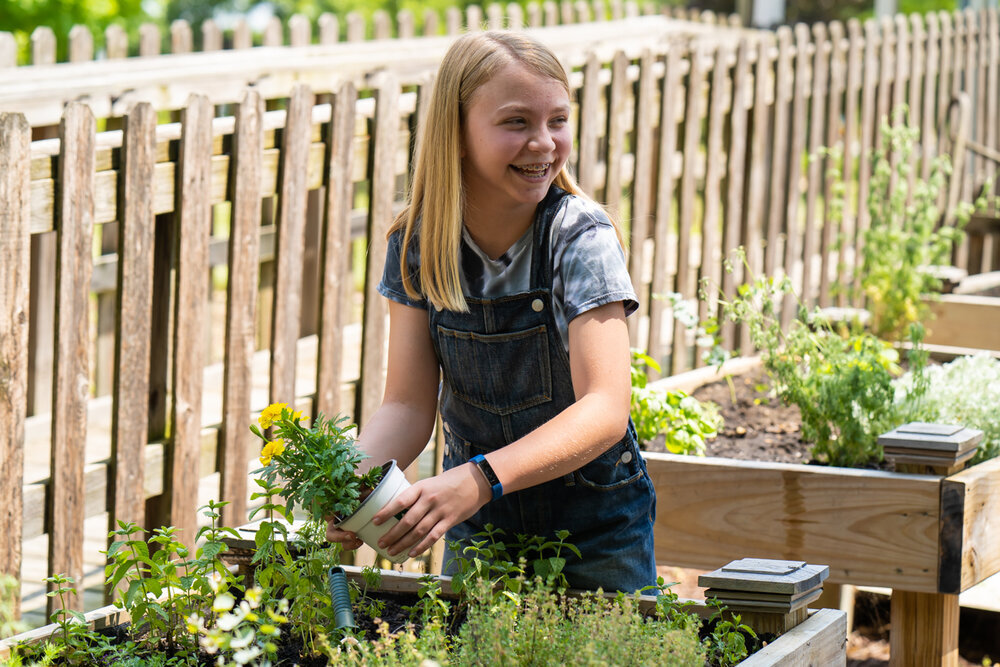The Sheldon Peck Homestead Gardens
How it all started…
“Grandma,” Martha peck ingalls, surronded by her prized hollyhocks in the peck garden, circa 1920
The Peck Homestead is the oldest house in Lombard. It was built by New Englander, Sheldon Peck, and his family in 1839. Peck was an itinerant folk artist and a Merino sheep farmer who came to Babcock’s Grove (now Lombard) in 1837.
The house was owned and occupied by the Peck family from its construction in 1839 to 1996, when it was donated to the Lombard Historical Society by Allen Mertz, great-great-grandson of Sheldon Peck. A joint Historical Society and Historical Commission restoration team joined with the Village of Lombard to preserve and restore the house.
The Pecks were all either gardeners or farmers. Current Peck Homestead trees, prairie grasses and wildflowers are native to Illinois. Wildflowers (Jack-in-the-pulpit, trillium, columbine, and bluebells) bloom in spring. Perennial flowers (daylilies, bleeding heart, hollyhock) grew by the outhouse (privy). Grasses with long root systems, like tall and short bluestem, sideoats grama, and northern drop seed, as well as flowers like coneflower and cardinal flower, grew in the summer.
Pam’s Garden - The Sheldon Peck Accessible Sensory Garden
The design and implementation of Pam’s Garden is the happy result of a joint collaboration of the efforts of Kim White, former Education Coordinator at the Lombard Historical Society, and the Lombard Park District. Kim, a self-taught naturalist inspired by her sister, Pam, whose arthritis limited her ability to engage in activities with her schoolmates and peers, created the plan and the Lombard Park District built the ramps, pathways, and raised gardens. The Garden is a delight for the senses and designed to be accessible and touchable to all.
pam’s garden; photo doug white, 2020
Help yourself to a few beans as you enter under the bean stalk covered arbor. Sample any of the other in season vegetables as you meander the friendly path; sweet peas here, green beans there, and pumpkins and cucumbers too.
The Garden is completely accessible to everyone; no need to kneel or sit on the ground with raised beds that are home to aromatic, textural and brightly colored plants. There are garden tools for building and digging and a seating area with benches to rest after all that fun and hard work.
The Lombard Garden Club & the Sheldon Peck Homestead
The Peck Homestead Garden was designed, established and is
maintained by the Lombard Garden Club for public education and enjoyment.
The Sheldon Peck Homestead gardens are a monarch waystation due to the
hard work and efforts of the Lombard Garden Club.
GARDEN FACTS
The plants in this garden must meet three criteria to be included:
the sheldon peck homestead gardens are a monarch waystation due to the efforts of the lombard garden club; photo lombard garden club
They are known to have historically lived in DuPage County at the time of the Peck Family's arrival.
They are true natives and provide food for birds and pollinators. (This garden meets the requirements to be a Monarch Waystation.)
They would be happy growing in your home garden and can be purchased from local sources.
We use no pesticides, herbicides, or synthetic fertilizers in this garden.
This garden was established by the Lombard Garden Club with the support of the Lombard Historical Society. It is maintained by Club members and community volunteers.
The Garden Blog
Check out the Peck Garden Blog to find out what’s new and exciting at the Peck Gardens!
The Plants
Jacob’s ladder; photo sheila collings
Jacob’s Ladder
One of the best features of the Jacob’s Ladder plant is its foliage. The plant forms a clump of densely packed leaf stems each bearing tiny leaflets, almost fern-like in appearance, that rise along the stem like the ladder of the Biblical dream of Jacob.
This ladder formation is known as pinnate. Each plant grows from 1 to 3 feet (30 to- 91 cm.) high with a spread of 1 1/2 to 2 feet (46 to 61 cm.) wide. Loose clusters of flowers hang like bells from the long stems and come in white, pink, blue or yellow depending on the cultivar.
Once established, growing Jacob’s ladder requires very little except for occasional trimming. Jacob’s ladder plants are, therefore, an excellent addition to the low maintenance garden.
https://www.gardeningknowhow.com/ornamental/flowers/jacobs-ladder/growing-jacobs-ladder-plant.htm
Tips for Your Garden
camassia (wild hyacinth); photo sheila collings
Camassia (Wild Hyancinth)
The flowers begin to bloom from the bottom of the raceme and continue to bloom upward toward the apex; each flower lasts only 2-3 days. The blooming period occurs from mid to late spring and lasts about 2-3 weeks. Each fertilized flower is replaced by a 3-celled seed capsule that is about 1/3" in length and nearly as much across. Each seed capsule contains many small seeds that are black and shiny. The basal leaves turn yellow and wither away by mid-summer. The root system consists of a bulb with fibrous roots. This wildflower reproduces by reseeding itself.
Cultivation: The preference is full sun to light shade, moist conditions, and rich loamy soil. Wild Hyacinth is slow to develop, but fairly long-lived. Vegetative growth and development occurs during the cool weather of spring, when adequate moisture is essential.
Range & Habitat: Wild Hyacinth is found occasionally throughout most of Illinois, where it is native. Habitats include moist black soil prairies, moist savannas, moist open woodlands (particularly along the banks of streams), rocky wooded slopes, and limestone glades. This species is typically found in high quality habitats, whether prairies or woodlands.
https://www.illinoiswildflowers.info/prairie/plantx/wild_hyacinth.htm








